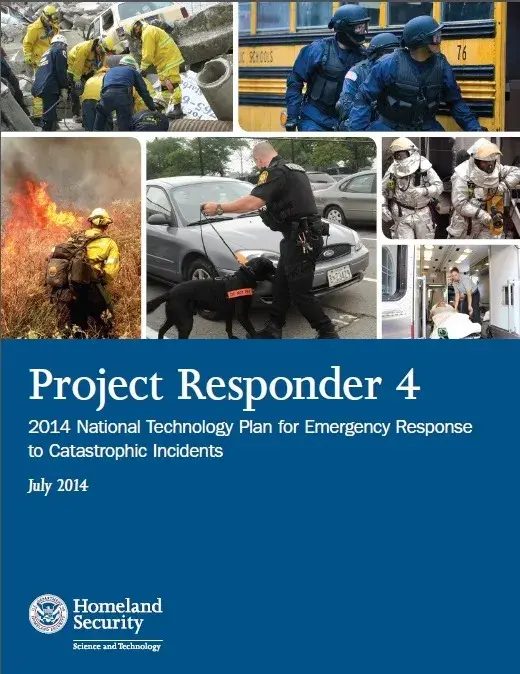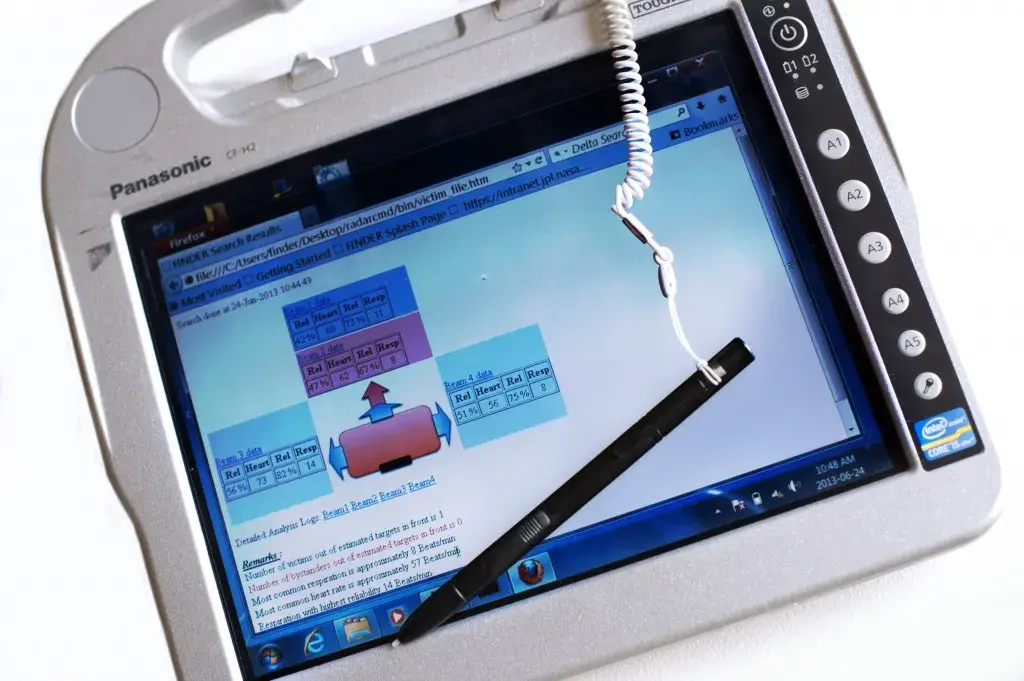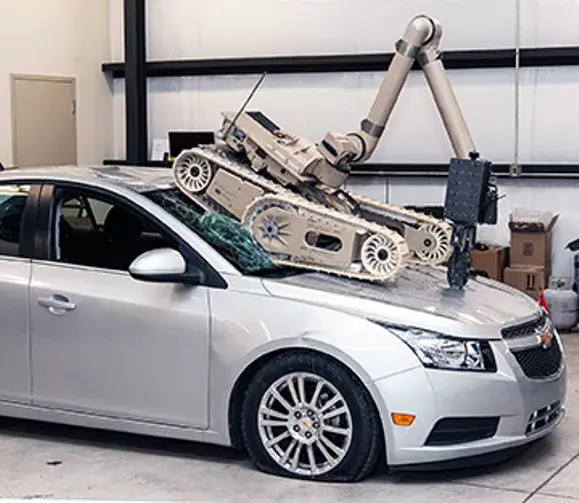The Department of Homeland Security (DHS) Science and Technology Directorate’s (S&T) First Responders Group (FRG) works with responders across all disciplines to develop solutions to the most pressing challenges they face—both daily and during times of emergency. Whether it is developing protective measures, providing training for first responders to teach them the latest response techniques, improving existing tools, or designing next-generation technologies, FRG is proud to partner with first responders to develop the resources they need to stay safe and enhance performance.
In 2014, several advances and innovations for the fire, law enforcement and emergency medical services communities were featured here on FirstResponder.gov. The following descriptions recap key milestones and project highlights from 2014.
Project Responder 4
First responders spoke and FRG listened. Project Resp onder 4 was the fourth iteration of a series of facilitated discussions with responders from across the country. These conversations yielded capability gaps that will inform FRG technology development moving forward. For instance, at a March 2014 workshop, responders indicated they need lighter all-hazards protective gear, complete with integrated sensors, heads-up displays and real-time, on-the-scene hazards information. In total, more than 150 federal, state and local first responders from 34 states and the District of Columbia contributed to the conversation.
onder 4 was the fourth iteration of a series of facilitated discussions with responders from across the country. These conversations yielded capability gaps that will inform FRG technology development moving forward. For instance, at a March 2014 workshop, responders indicated they need lighter all-hazards protective gear, complete with integrated sensors, heads-up displays and real-time, on-the-scene hazards information. In total, more than 150 federal, state and local first responders from 34 states and the District of Columbia contributed to the conversation.
FRG disseminated the feedback it received via a report released in September 2014 that covers several broad thematic areas, including situational awareness; communications, command, control and coordination; responder health, safety and performance; and training and exercise.
Improved Structure Firefighting Glove
Developed with NanoSonic and Shelby Specialty Gloves, FRG’s Improved Structure Firefighting Glove was constructed using a combination of traditional materials and NanoSonic’s HybridShield®, a Kevlar®-based insulation. The resulting product is the first of its kind—gloves that are lightweight, water-repellent, and heat- and puncture-resistant with enhanced dexterity and don and doff ability.
In April 2014, Technology Development Director, R-Tech, Greg Price and the National Urban Security Technology Laboratory (NUSTL) led an operational field assessment of the glove at the Northeastern Illinois Public Safety Training Academy. Participants evaluated the glove’s form, fit and flexibility while performing daily tasks such as tying ropes, manipulating hoses and operating hydraulic rescue tools.
Also in April, FRG hosted a Twitter Chat highlighting the glove; participating responders used the opportunity to contribute feedback from the field assessment.
“Overall this glove is a vast improvement over the comparable gloves that I have worked with,” Lieutenant Jason Smith of Montgomery County (Maryland) Fire and Rescue Service tweeted. “These could potentially replace the rescue/extrication/structure gloves that I carry now. No need to carry 3 sets of gloves.”
The glove received National Fire Protection Association (NFPA) certification in October 2014 and is now commercially available from Shelby Specialty Gloves.
Video: Improved Structure Firefighting Gloves
Virtual Shooter
The Virtual Shooter is a device that mimics the movements and reactions of a human firing a gun. Together with U.S. Immigration and Customs Enforcement (ICE) and Radiance Technologies, FRG developed a robotic prototype of the device to mechanically test a wide range of firearms and ammunition. The prototype was built to the specifications of ICE’s Office of Firearms and Tactical Programs (OFTP), which manually fires more than 200,000 rounds every year—often resulting in injuries similar to carpal tunnel syndrome. The goal is to have the Virtual Shooter take on some of this firing load to minimize the number of injuries to ICE officers from recoil, ejection cycles and other movements.
FRG Program Manager John Price tested the Virtual Shooter prototype with project partners on several occasions in 2014. In late March, Price led a week of exercises at the ICE National Armory in Altoona, Pennsylvania. “This technology will reduce the wear and tear on our officers,” said ICE Supervisory Engineer Lowell Johnson. Additional tests were held at a federal firing range in Alexandria, Virginia, in November.
The Virtual Shooter project is funded through the Small Business Innovation Research program, an awards-based initiative that matches small businesses with federal agencies for innovative research and development (R&D) purposes. Currently in the project’s final phase, the Virtual Shooter will be transitioned to the ICE National Armory in spring 2015.
Video: Virtual Shooter in 100 Seconds
Finding Individuals for Disaster and Emergency Response
FRG’s Find ing Individuals for Disaster and Emergency Response (FINDER) project reached several milestones in 2014. The technology, developed in partnership with the NASA Jet Propulsion Laboratory (JPL), detects life trapped under rubble and building debris in the aftermath of a disaster. FINDER uses low-power microwave radar to detect breathing and heartbeats and has the ability to distinguish between humans, animals and mechanical movements. FINDER quickly directs rescuers to victims, thereby allowing additional victims to be identified and rescued.
ing Individuals for Disaster and Emergency Response (FINDER) project reached several milestones in 2014. The technology, developed in partnership with the NASA Jet Propulsion Laboratory (JPL), detects life trapped under rubble and building debris in the aftermath of a disaster. FINDER uses low-power microwave radar to detect breathing and heartbeats and has the ability to distinguish between humans, animals and mechanical movements. FINDER quickly directs rescuers to victims, thereby allowing additional victims to be identified and rescued.
Over the course of the year, FRG Program Manager John Price and NASA JPL staff demonstrated FINDER to first responders across the nation. In May, the team briefed members of the Oklahoma Urban Search and Rescue (USAR) Task Force and the Tulsa (Oklahoma) Fire Department on FINDER’s capabilities and gathered input on how FINDER improves their response efforts. Several USAR task forces in California, Florida, Indiana, New Jersey and Virginia were sent a FINDER unit to test and evaluate. In August, FINDER was demonstrated for members of the Chicago Fire Department.
In September the FINDER team participated in Urban Shield—a full-scale regional preparedness exercise assessing response and recovery in a high-threat, high-density urban area in the San Francisco Bay area. FRG and NASA JPL participated in a debriefing with team leaders, incident commanders and hostage negotiators. First responders attending the event also provided feedback on how the technology could potentially aid them and be integrated into law enforcement response protocols.
FINDER continues to impress users and the development team plans to announce new functions and features in early 2015. A field assessment is also planned for early 2015, during which NUSTL will formally test and document FINDER’s performance with the New York City fire and police departments.
Video: FINDER the Bigger Story
Wildland Firefighter Advanced Personal Protection System
 FRG concluded its Wildland Firefighter Advanced Personal Protection System program in late 2013. The program was a two-year effort to develop an NFPA-certified garment system for responders that improved radiant thermal protection; reduced heat stress; and improved the form, fit and function of the garment ensemble.
FRG concluded its Wildland Firefighter Advanced Personal Protection System program in late 2013. The program was a two-year effort to develop an NFPA-certified garment system for responders that improved radiant thermal protection; reduced heat stress; and improved the form, fit and function of the garment ensemble.
FRG, the U.S. Army Natick Research, Development and Engineering Center, the California Department of Forestry and Fire Protection, California county and local fire agencies and the U.S. Forest Service collaborated for more than two years, researching, developing and performing system tests on approximately 1,000 new ensembles for wildland firefighters in both laboratory and real-world fire scenarios. The findings were released in a report in June 2014, and it is anticipated that the new garment ensemble will be available to first response agencies in 2015.
Low Light Internet Protocol-Based Surveillance Camera and Digital Encoder
Although there are many small, easy-to-conceal cameras on the market today, none offers the full range of capabilities that undercover surveillance operations require. During surveillance operations, law enforcement officers place live-feed surveillance cameras in target areas and review footage remotely from PDAs, laptops and desktop computers. Officers often face the challenge of conducting surveillance because of slow Internet connectivity, low bandwidth Internet issues, and environments with low or dim lighting. However they need to produce videos in which people are conclusively identified under a variety of low visibility conditions.
FRG, in collaboration with ICE Homeland Security Investigations (ICE-HSI), worked with Industrial Video and Control (IVC) and Digital Barriers to develop an advanced remote surveillance system. The system consists of two separate parts that complement one another—a camera and an encoder.
The IVC low light Internet Protocol (IP)-based surveillance camera (low light camera) is capable of covert, low light tilt, pan, and zoom video surveillance. This low light, IP-based surveillance camera also provides high quality identifiable video, which can be used for prosecution. ICE-HSI received a prototype and tested it in September 2014. The camera was successfully commercialized and can only be purchased by active law enforcement responders or agencies. Additional information on the low light camera can be obtained on the IVC website.
The Digital Barriers high-definition (HD) encoder (TVI HD-S600) compresses and transmits video data captured by the low light camera. It provides law enforcement personnel the ability to capture multiple frames of HD video per second over low-bandwidth networks (e.g. 3G cellular). ICE-HSI received a prototype and tested it in September 2014. The encoder was also successfully commercialized.
Prepaid Card Reader
FRG worked with the ERAD Group (formerly Paymentcard Services, Inc.) and ICE-HSI to develop a prepaid card reader that allows law enforcement to quickly assess cards with magnetic strips and determine if they are associated with criminal activity. The software solution is capable of reading the magnetic strip on any card and allows the officer to take additional action if desired.
The project produced 10 prototypes, which were delivered to S&T in early 2014. The prepaid card reader is available from the ERAD Group.
Radio Internet Protocol Communications Module
 The Radio Internet Protocol Communications Module (RIC-M) is a low-cost, external, stand-alone, interface device that allows response agencies to easily upgrade and reconfigure their legacy base station systems for less than $500, extending the life of many older base station systems by 10 to 20 years. RIC-M meets all digital Project 25 (P25) compatible standards, ensuring equipment can reliably communicate, regardless of manufacturer. It also ensures a higher degree of interoperability among different systems, which can save limited agency funds by eliminating the need to replace otherwise-serviceable equipment to achieve interoperability.
The Radio Internet Protocol Communications Module (RIC-M) is a low-cost, external, stand-alone, interface device that allows response agencies to easily upgrade and reconfigure their legacy base station systems for less than $500, extending the life of many older base station systems by 10 to 20 years. RIC-M meets all digital Project 25 (P25) compatible standards, ensuring equipment can reliably communicate, regardless of manufacturer. It also ensures a higher degree of interoperability among different systems, which can save limited agency funds by eliminating the need to replace otherwise-serviceable equipment to achieve interoperability.
RIC-M connects radio frequency (RF) system base stations, consoles and other RF equipment—regardless of brand—over the Internet or private IP networks. RIC-M converts from a commonly used V.24 serial communications protocol to an open-standard voice over IP. Both encrypted and unencrypted P25 digital communications are supported, and it can also operate with analog communication equipment.
In November 2013, the U.S. Department of Interior Radio Laboratory in Denver, Colorado, field tested a prototype. In July 2014, production-ready RIC-Ms were distributed for further base station testing. Agencies participating in the testing included U.S. Customs and Border Protection, the U.S. Marshals Service (for use with the FBI); Bureau of Alcohol, Tobacco, Firearms and Explosives and the Drug Enforcement Administration), the Federal Protective Service, and the Montgomery County (Maryland) Fire and Rescue Service. S&T has applied for a utility patent and will soon file a trademark application for RIC-M.
Read: New Tool Helps Responders Communicate
Response and Defeat Operations Support
Through its Response and Defeat Operations Support (REDOPS) program, FRG works with the FBI’s Federal Electronic Countermeasures (ECM) program to fund R&D of advanced capabilities to ensure the safety and effectiveness of public safety bomb technicians. The program aims to close the gap between the current capabilities of state and local bomb squads and the capabilities they need to handle the growing threat of domestic improvised explosive devices (IEDs). It is one of a series of projects undertaken in partnership with the National Bomb Squad Commanders Advisory Board, DHS Office for Bombing Prevention, FBI Hazardous Devices Operations Center, and Defense Threat Reduction Agency (DTRA).
Throughout 2014, FRG and its partners worked on ECM to provide the nation’s 469 accredited public safety bomb squads with protection from terrorists remotely detonating radio-controlled IEDs. Currently in Phase I, testing occurred at the Naval Air Weapons Station China Lake in 2014. Results are being analyzed to determine an ECM performance baseline and assess how ECM systems operate independently in a domestic setting against domestic threats.
In September, the FBI’s Law Enforcement Online (LEO) website posted a REDOPS program briefing. Establishing a partnership with the FBI and being recognized as the R&D arm for response and defeat of explosive ordnance devices are important steps in keeping civilian bomb technicians across the country informed about REDOPS’ efforts to address their highest-priority technology needs.
 For five days in mid-December 2014, at the General Motors Milford Proving Ground in Michigan, 15 bomb disposal robots from eight manufacturers faced simulated threats ranging from suicide bombers to vehicle-borne IEDs. The event was one of a series of technology assessments being conducted by DHS and DTRA in cooperation with the FBI. The assessment program is part of a larger effort to strengthen support for state and local bomb squads.
For five days in mid-December 2014, at the General Motors Milford Proving Ground in Michigan, 15 bomb disposal robots from eight manufacturers faced simulated threats ranging from suicide bombers to vehicle-borne IEDs. The event was one of a series of technology assessments being conducted by DHS and DTRA in cooperation with the FBI. The assessment program is part of a larger effort to strengthen support for state and local bomb squads.
Also in December, FRG REDOPS program staff participated in a demonstration of the Laminated Glass Portal Charge in Fairfax, Virginia. The device is fabricated by bomb squads to investigate suspected IEDs inside locked vehicles. It uses multiple strands of detonation cord to safely punch openings in laminated vehicle windows and windshields. The FBI will soon release a technical bulletin for bomb technicians detailing the fabrication method and proper procedures for using the device.
